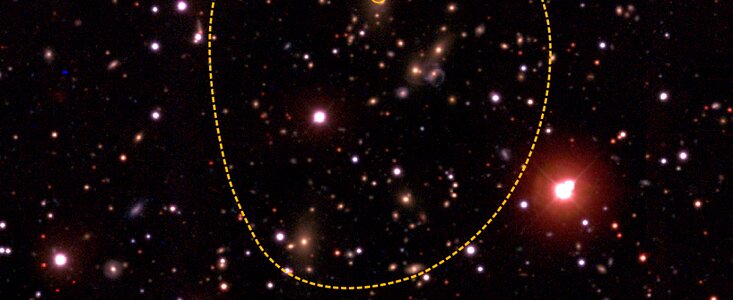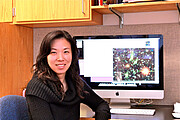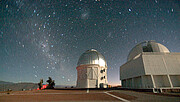NOAO: Galaxy clusters may offer critical clues to Dark Energy
19 November 2012
One of the major puzzles in astronomy today is the nature of the mysterious force that astronomers have dubbed Dark Energy. And one tool in understanding this force is encoded in the distribution of clusters of galaxies in the Universe. Thus, new work by a team of astronomers that has yielded exquisitely precise distances of a large sample of clusters may lead to breakthroughs in understanding the expansion history of our Universe.
Astronomers have known for over 80 years that our Universe is expanding from an event called the Big Bang. In 2011, the Nobel Prize in physics was awarded for the even more exciting discovery that the rate of expansion is increasing, rather than slowing down as might be expected. The cause of this acceleration, referred to as Dark Energy, is not understood.
As Dr. Jeeseon Song, lead author of the study, remarked: “By looking at galaxy clusters at different epochs in cosmic history, astronomers can explore whether Dark Energy has acted differently at different times in the history of the Universe. Galaxies, including our own Milky Way galaxy, are vast assemblages of stars and gas. Clusters of galaxies, conglomerates of tens to hundreds of galaxies, are the largest structures in the Universe. They are dynamically changing and aging over time. And that is very crucial in cosmological studies, because that’s where we can see how Dark Energy is acting on the Universe, pulling the clusters apart.” By studying the distribution of clusters at different times in the past, astronomers detect what the Dark Energy does to the Universe, allowing them to figure out what the Dark Energy itself is.
The team has identified an important sample of galaxy clusters whose distances have been determined accurately enough to study how the density of galaxy clusters varies with the age of the Universe. To do this, they began with observations from the South Pole Telescope, a millimeter-wavelength survey telescope. Crucial follow-up work at the Blanco 4-meter telescope at Cerro Tololo Inter-American Observatory enabled them to refine cluster distances to within a few percent. The Blanco telescope, located in northern Chile, celebrates its 50th anniversary this year, but with modern instrumentation such as the Mosaic camera used in this study, it still plays a vital role in cutting edge research.
It has been known for decades that in the expanding universe the farther away an object is, the faster it is receding from us. Measuring velocity is based on an effect seen in everyday life: as an object moves further away, its light shifts to longer, or red, wavelengths (called redshift). As an object moves closer, the light wavelengths shorten, shifting to blue. This Doppler shift of light waves is used by highway patrols to measure the velocity of cars on the highway.
Because of the expansion of the Universe, objects with large redshifts are not only far away, they are also observed as they were a long time in the past. When measuring distant objects in the Universe, astronomers refer to the redshift using the letter z. The galaxy clusters in this study have an average redshift, z, of about 0.6. At this redshift the Universe was only about half of its present age of 13.7 billion years. But the clusters span a range in distance from those close enough to be seen almost as they are in the present universe, to some with z as large as 1.4, which means we see them as they appeared when the Universe was less than a third of its present age.
A related discovery from this work concerns what are called Brightest Cluster Galaxies, or BCGs – the biggest and brightest galaxy in each cluster. As Alfredo Zenteno, the second author of this paper, said: “The position of a BCG within a cluster indicates if the cluster is undergoing some violent internal motion – perhaps because it has suffered a smashup with another cluster. By studying the frequency of such collisions, we learn if these clusters are unique or not. This is crucial to understanding Dark Energy in clusters.”
More information
Cerro Tololo Inter-American Observatory (CTIO) is a division of the National Optical Astronomy Observatory (NOAO), which is operated by the Association of Universities for Research in Astronomy Inc. (AURA) under a cooperative agreement with the National Science Foundation.
Contacts
Dr. Jeeseon Song
University of Michigan Department of Physics Randall Laboratory
450 Church Street Ann Arbor MI 48105, USA
Email: jeeseons@umich.edu
Alfredo Zenteno
Ludwig-Maximilians-University Faculty of Physics
Scheinerstr. 1, D-81679 Munich, Germany
Email: alfredo@usm.lmu.de
About the Release
| Release No.: | noao1206 |
| Legacy ID: | NOAO 12-06 |
| Facility: | Víctor M. Blanco 4-meter Telescope |
| Instruments: | NEWFIRM |
| Science data: | 2012ApJ...761...22S |





